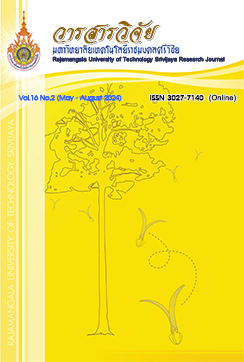Particle Size and Stability of Calcium Fortified Sterilized Goat Milk and Consumer Acceptance
Keywords:
goat milk, calcium, sterilization, stabilizerAbstract
Addition of calcium compounds affects particle size and induces sedimentation of milk products. This study compared skim milk particle size of raw goat milk, sterilized goat milk, and sterilized goat milk supplemented with 30 mM tricalcium phosphate by Laser diffraction Mastersizer X. The mean particle sizes were 0.543, 1.063 and 2.603 μm, respectively. A study of sediment content and color to be a guideline for calcium supplements containing goat milk was compared in 5 trials: 1) sterilized goat milk, 2) calcium sterilized goat milk, 3) sterilized goat milk treated with calcium and supplemented with 0.025% (w/w) carrageenan (C), 4) 1% (w/w) disodium hydrogen phosphate (DSHP), and 5) 1% (w/w) trisodium citrate (TSC). The results found that the addition of DSHP and TSC resulted in lower milk lightness, higher in red and yellow value, and greater sediment formation. During 90 days of storage, the sediment content of treatments using stabilizers was not different. Based on the findings of a survey involving 150 consumers, four dominant factors emerged as significant influencers of milk purchasing behavior: health benefits, accessibility, quality certifications, and convenience of consumption. In this study, sterilized goat milk fortified with 30 mM tricalcium phosphate was accepted by 88.32% of consumers.
References
Boumpa, T., Tsioulpas, A., Grandison, A.S. and Lewis, M.J. 2008. Effects of phosphates and citrate on sediment formation in UHT goats’ milk. Journal of Dairy Research 75(2): 160-166.
Chen, B.Y., Grandison, A.S. and Lewis, M.J. 2012. Comparison of heat stability of goat milk subjected to ultra-high temperature and in-container sterilization. Journal of Dairy Science 95(3): 1057-1063.
Chilliard, Y., Ferlay, A., Rouel, J. and Lamberet, G. 2003. A review of nutritional and physiological factors affecting goat milk lipid synthesis and lipolysis. Journal of Dairy Science 86(5): 1751-1770.
Deeth, H.C. and Lewis, M.J. 2015. Practical consequences of calcium addition to and removal from milk and milk products. International Journal of Dairy Technology 68(1): 1-11.
Department of health. 2020. Thai recommended daily intakes. A.V. Progressive, Bangkok. (in Thai)
Department of Trade Negotiations. 2022. Milk and milk products. Available source: https:// www.dtn.go.th/th/file/get/file/milk and milk products, August 22, 2022 (in Thai)
Devi, A.F., Buckow, R., Singh, T., Hemar, Y. and Kasapis, S. 2015. Color change and proteolysis of skim milk during high pressure thermal-processing. Journal of Food Engineering 147: 102-110.
Guerra-Hernandez, E., Leon, C., Garcia-Vaillanova, B. and Romera, J.M. 2002. Chemical changes in powdered infant formulas during storage. International Journal of Dairy Technol 55(4): 171-176.
Hawae, F., Pinkaew, S. and Pakdeechanuan, P. 2019. Application of fourier transform infrared spectroscopy for analysis the stability of calcium fortified sterilized goat, cow and soy milk, pp. 34-41. In The 21st Food Innovation Asia Conference 2019. Food Science and Technology Association of Thailand, Bangkok.
Jutanan, M. 2010. Characteristic of goat milk collected from enterprises in three southern border provinces. Master of Science (Food Science and Nutrition), Prince of Songkla University. (in Thai)
Kaushik, R., Sachdeva, B. and Arora, S. 2014. Heat stability and thermal properties of calcium fortified milk. CyTA-Journal of Food 13(2): 1-7.
Lewis, J.M. 2010. The measurement and significance of ionic calcium in milk-A review. International Journal of Dairy Technology 64(1): 1-13.
McMahon, D.J. and Oommen, B.S. 2013. Casein micelle structure, functions and Interactions: Advanced Dairy Chemistry: Proteins. 4thed. Springer, New York.
Münchbach, M. and Gerstner, G. 2010. Calcium fortification in dairy products. Food Marketing and Technology 24: 4-8.
National Bureau of Agricultural Commodity and Food Standard. 2008. Raw goat milk. Available source: https://www.acfs.go.th/ standard/download/raw_goat_milk.pdf, June 2, 2022. (in Thai)
Palacios, C., Cormick, G., Hofmeyr, G.J., Garcia-Casal, M.N., Peña-Rosas, J.P. and Betrán, A.P. 2021. Calcium-fortified foods in public health programs: considerations for implementation. Annals of the New York Academy of Science 1485(1): 3-21.
Pathomrungsiyounggul, P., Lewis, M.J. and Grandison, A.S. 2010. Effects of calcium-chelating agents and pasteurization on certain properties of calcium-fortified soy milk. Food Chemistry 118(3): 808-814.
Pesic, M.B., Barac, M.B., Stanojevic, S.P., Ristic, N.M., Macej, O.D. and Vrvic, M.M. 2012. Heat induced casein–whey protein interactions at natural pH of milk: A comparison between caprine and bovine milk. Small Ruminant Research 108(1): 77-86.
Pesic, M.B., Barac, M.B., Stanojevic S.P. and Vrvic, M.M. 2014. Effect of pH on heat-induced casein-whey protein interactions: A comparison between caprine milk and bovine milk. International Dairy Journal 39(1): 178-183.
Ramos, M. and Juarez, M. 2011. Sheep milk. Encyclopedia of Dairy Sciences 3(2): 494-502.
Sharma, S.K., Mulvaney, S.J. and Rizvi, S.S.H. 2000. Food Process Engineering. John Wilen & Son Inc, Toronto, Canada.
Singh, G. and Muthukumarappan, K. 2008. Influence of calcium fortification on sensory, physical and rheological characteristics of fruit yogurt. LWT - Food Science and Technology 41(7): 1145-1152.
Tsioulpas, A., Koliandris, A., Grandison, A.S. and Lewis, M.J. 2010. Effects of stabilizer addition and in-container sterilization on selected properties of milk related to casein micelle stability. Food chemistry 122(4): 1027-1034.
Downloads
Published
How to Cite
Issue
Section
License
Copyright (c) 2024 Rajamangala University of Technology Srivijaya Research Journal

This work is licensed under a Creative Commons Attribution-NonCommercial-NoDerivatives 4.0 International License.
The content and information in the article published in Journal of Rajamangala University of Technology Srivijaya It is the opinion and responsibility of the author of the article. The editorial journals do not need to agree. Or share any responsibility.







